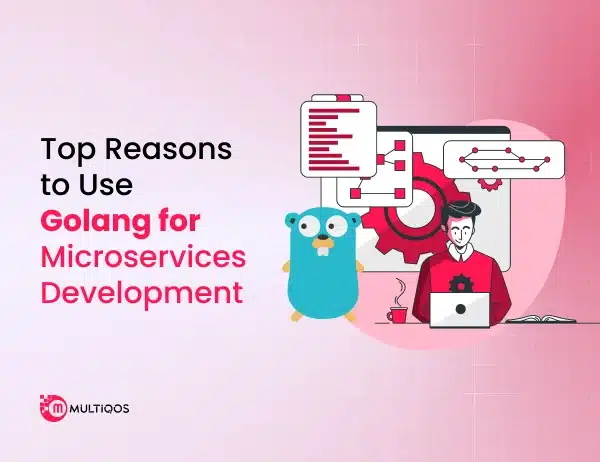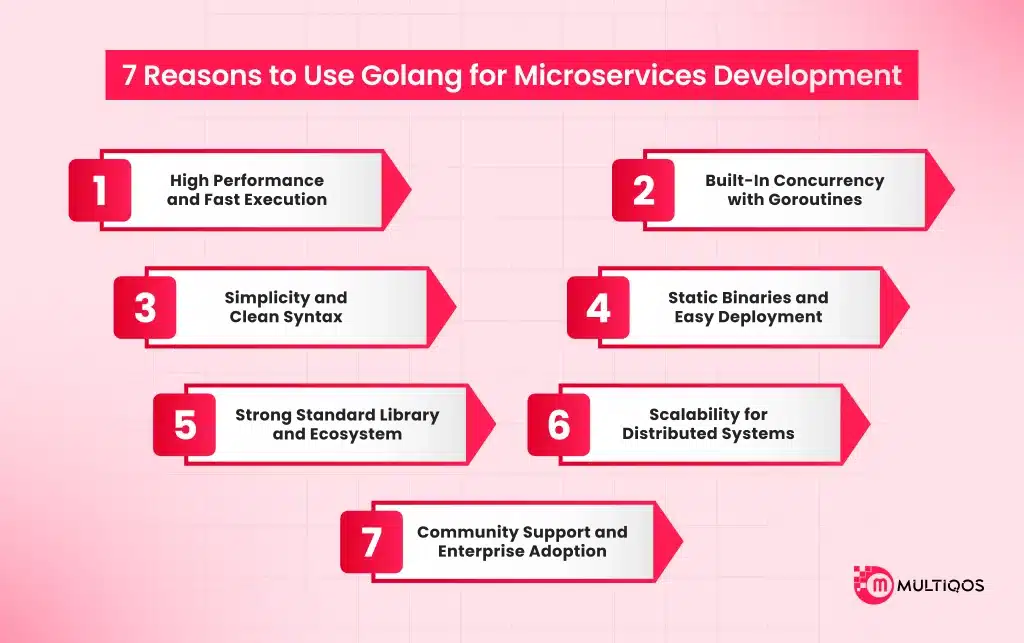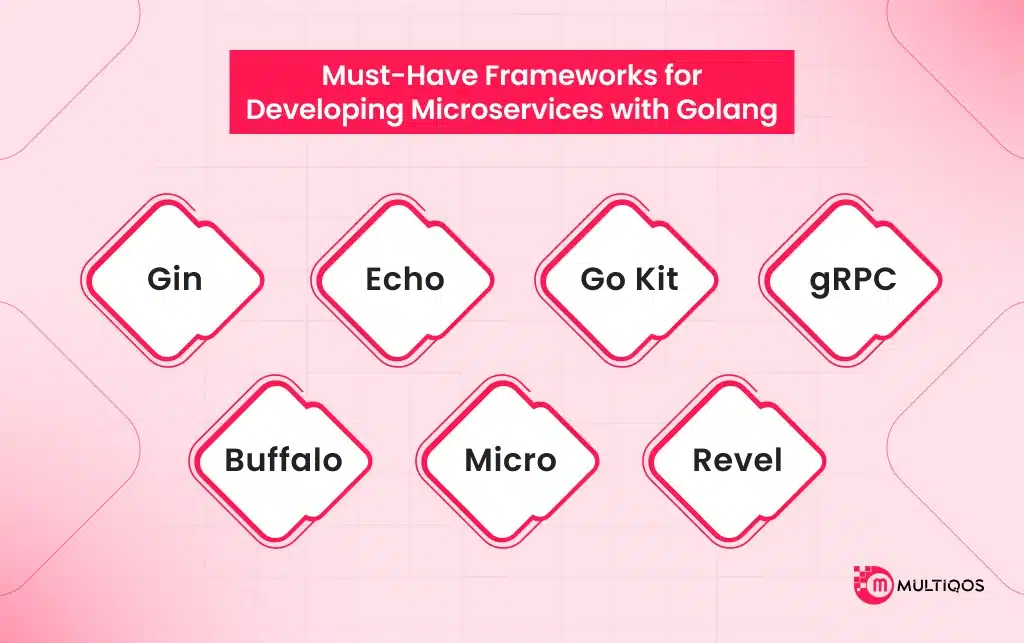Top Reasons to Use Golang for Microservices Development

Summary:
Golang has emerged as a top contender for building microservices, thanks to its exceptional performance, built-in concurrency support, and simplicity in code structure. In this blog, we explore the key reasons developers and enterprises adopt Golang for microservices development.
We break down how Go addresses modern backend challenges from its lightweight architecture and fast compilation to strong standard libraries and seamless scalability. Whether migrating from a monolith or building distributed systems from scratch, this article will help you understand why Golang is a smart, future-ready choice for microservices architecture.
Introduction
The microservices architecture is the most preferred one today because it provides ease of scaling, maintaining, and building resilient applications. However, selecting the appropriate programming language to complement this architecture is equally, if not more, important than designing the services themselves. That is the area where Golang excels.
Golang, or Go, was created at Google. Its value is now being recognized by backend engineers and enterprise teams due to its straightforward syntax, speed, and overall performance. Also, Go’s small, lightweight footprint combined with its powerful concurrency model makes it an exceptional candidate for microservices, which are often resource-sensitive and require high responsiveness. In this blog, we will analyze the top reasons why using Golang for microservices development is not merely a trend but rather an enduring strategy for modern application development.
7 Reasons to Use Golang for Microservices Development
1. High Performance and Fast Execution
Like most programming languages, Golang is advantageous due to its ability to be compiled straight to machine code. These features mark it as superior to executed languages. This translates to Golang being favorably used in microservices, which are performance-sensitive and have repetitive handling of requests with little delay. Lastly, Go applications are noted for having low startup periods, which renders them beneficial in serverless and containerized settings where fast initiation is vital.
2. Built-In Concurrency with Goroutines
Among various programs, Golang’s native concurrency model stands out the most. Its runtime allows the creation of thousands of lightweight threads, dubbed ‘goroutines’. This enhances the efficiency of executing concurrent tasks, making it better suited for microorganisms that handle multiple processes at the same time. Channels, another key aspect of Go’s concurrency management, facilitate safe and organized parallelism by protecting communication between goroutines.
3. Simplicity and Clean Syntax
Simplicity and clarity are valued in Go. Its clear syntax mitigates a developer’s mental workload and bugs. This improves development speed and simplifies maintenance, which is crucial in a system with numerous microservices. Also, Go’s omission of complex features like inheritance and annotations enhances focus and uniformity across teams.
4. Static Binaries and Easy Deployment
Golang compiles into a single static binary with no external dependencies, thus easing implementation across different environments. This makes it ideal for Microservices deployed through Docker or Kubernetes. Apart from self-contained binaries enlarging in size, they also reduce images and improve efficiency in the CI/CD pipeline.
5. Strong Standard Library and Ecosystem
Golang’s powerful standard library includes web server components, I/O operations, and networking, which drastically reduces the need for third-party libraries, resulting in more stable, secure applications. The Go ecosystem has many popular frameworks and tools such as Gin, Echo, and Revel which foster rapid development in the backend.
6. Scalability for Distributed Systems
Golang’s scalability makes it suitable for use in containerized ecosystems. It is optimized for execution in multi-core environments, which is critical for the horizontal scaling of microservices in actual production settings. The performance attributes of Golang along with its capacity to control thousands of simultaneous operations is perfect for microservices management.
7. Community Support and Enterprise Adoption
Golang does have strong community support, as it is backed by major players like Google. Also baked into the system by Uber, Dropbox, Netflix, and Docker proves reliability and is effective for large-scale systems. Goes active was maintained and had a growing ecosystem of partners offering regular updates.
Must-Have Frameworks for Developing Microservices with Golang
Using the appropriate tools and frameworks when building microservices with Golang can immensely improve productivity, performance, and maintainability. Listed below are some critical frameworks that have been received well among Go developers:
1. Gin
Gin is one of the most sought-after web frameworks used by Golang for microservices. It can be used to develop web APIs because of its performance and a wide variety of offered functionalities. It is a small memory space and has an outstanding speed, which makes it ideal for microservices.
2. Echo
Echo is another high-performant web framework for Go. Like others, it has a clean and extendable API, powerful routing, built-in middleware, and more.
3. Go Kit
Go Kit assists in constructing maintainable, reliable, and scalable microservices. It has provisions for service discovery, transport, logging, and instrumentation. The completion of these functions makes Go Kit aids in best practices for defining the architecture of distributed systems.
4. gRPC
gRPC is an enhanced RPC framework that was developed by Google. It uses Protocol Buffers to allow interaction between services without loss of efficiency. gRPC is well-suited for Go, low-latency, high-throughput microservices, both in terms of throughput and servicing, making it advantageous in those scenarios.
5. Buffalo
All the features a developer could wish for are packed into Buffalo, including routing, templating, and already built asset tools. Everything you’d expect in a full-fledged web application framework. If your goal is to scaffold Go programs swiftly, especially integrating pre-existing microservices, it is even more helpful.
6. Micro
Focusing on the ease of developing and maintaining distributed systems, Micro is a microservices toolkit based on the Go programming language. Other than having an easy-to-use interface, it also comes with integrated service discovery, load balancing, message encoding, and monitoring features.
7. Revel
Revel is a full-featured MVC framework for Go, but it is less minimal than Gin or Echo. It is preloaded with features such as routing, request/response handling, and templating, which makes it a great choice for bigger applications.
When Should You Choose Golang for Microservices?
Select Go for microservices when you need superior performance, scaling, and concurrency handling. It is well-suited for architecture with stringent requirements involving low latency, high resource efficiency, and quick deployment within containers or clouds.
Golang development stands out if you need quick compilation, simple cross-platform deployment, and a strong standard library to limit external dependencies. Go offers the speed and ease of use needed for crafting and managing microservices, irrespective of whether you are on a growing startup or juggling a large-scale enterprise infrastructure.
Final Thoughts
Golang is one of the versatile programming languages and microservice architectures that have proved to be assisting developers in offering reliable solutions and aiding in the development of microservices. The performance of Go is unparalleled as it has compiled-level speed, supports concurrent operations natively, has an easy-to-understand grammar, and provides excellent basic toolsets.
Developers can build advanced levels of microservices that meet the requirements, are convenient to manage, and can be smoothly integrated. No matter where you begin, be it enhancing your backend systems or creating distributed services, its adoption helps teams operate faster and offers unparalleled scalability, hence enhancing their productivity tremendously.
When you’re ready to advance your architecture, it is time to hire Golang developers who are experts in using Go’s potential for microservices. With the right skills, you can create systems that are not only optimally performing but also resistant to obsolescence.
FAQs
Go is popular for microservices since it’s performant, has a low resource usage, and supports concurrency. These characteristics make it easier to develop big, complex systems that contain multiple independently distributed services with efficient communication between services.
As always, it is about your project needs. When comparing Java and Node.js, Golang performs better when it comes to application startup time and memory utilization. It also provides easier concurrency management than Java’s threads or Node’s event loop, further improving parallel tasks in microservices.
When considering hiring backend developers, having experience with Golang should be a requirement for microservices projects since the Go language makes high-performance, efficient concurrency, and scaling easy. Proficient Go developers can create microservices that are both lightweight and self-sufficient in communication and scaling. To achieve a dependable, scalable backend infrastructure, hire backend developers who understand fully the capabilities of Golang and need to be onboarded.
Absolutely, Golang is built to handle high loads effectively and can smoothly run large microservice systems. Many companies, such as Google, Uber, and Netflix, employ parts of Golang in their microservices system infrastructure.
Key advantages are quick execution, effortless deployment due to static binaries, simple syntax, a vast standard library that minimizes reliance on external packages, robust concurrency capabilities, and, last but not least, superior system and network programming.
When searching for candidates, check if they have worked with building distributed systems alongside having an understanding of RESTful APIs or gRPC, as well as Docker and Kubernetes. In addition, these developers can be found easily through a reliable development firm, which will also ensure quality outcomes.
Get In Touch








